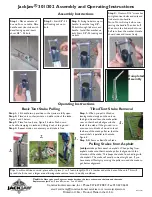
AMBE-2000™ Vocoder Chip Users Manual
Version 4.92, June, 08
DVSI Confidential Proprietary, Subject to Change
Page 23
Visit us at
www.dvsinc.com
4
Channel Interface
4.1
Overview
The Channel Interface is the general term used for the interface for the compressed bits coming from the encoder and the
compressed bits going to the decoder. This same interface is also used to output status information from the encoder and
decoder such as whether a DTMF tone has just been detected in the speech input, or whether the decoder has detected and
synthesized a frame of silence. Additionally, this interface is used to perform more complex control operations on both the
encoder and decoder (usually at start-up). These control functions include speech data and FEC rate control.
It is important to realize that not all data being output from the AMBE-2020™ is intended for transmission over the channel.
Status type of data is typically only useful at the ‘local’ end. In most voice transmission systems, the actual encoded bits are
extracted from the channel formatting, combined into the systems transmission stream, sent over the transmission path,
extracted from the transmission path at the receiving end, and reassembled into the AMBE-2020™ ’s channel format for
synthesis by the decoder.
Figure 4-A Channel Interface Overview
Overhead Data
(Header, Status)
Voice Data (40 to 192 bits)
System extracts
relevant Voice Data bits
and formats them for
transmission over
Channel
System Overhead
Voice Data (40 to 192 bits)
Typical Voice Frame Output From Encoder
Overhead Data
(Header, Control)
Voice Data (40 to 192 bits)
Typical Voice Frame Input to the Decoder
System extracts
relevant Voice Data bits
and formats them for
Input into the Decoder
adding Header and
Control Information
Transmission Channel
















































